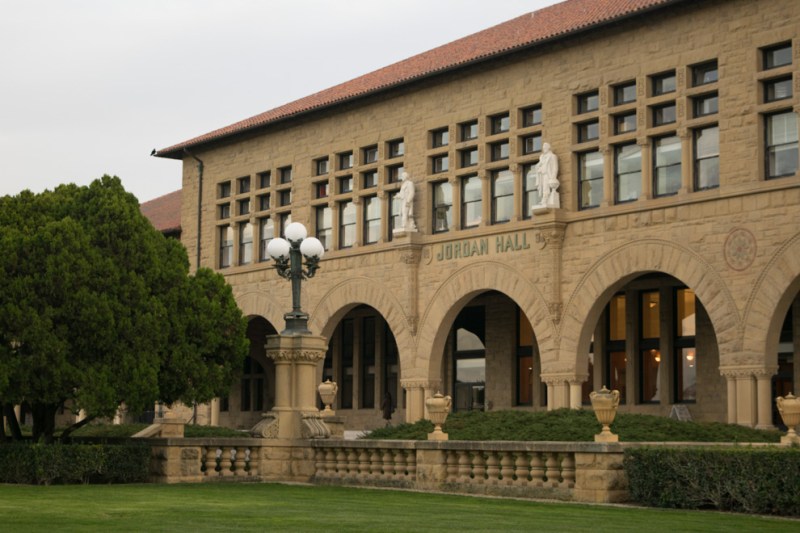The Eugenics at Stanford History Project, a group primarily seeking to unveil historical ties between Stanford and the American eugenics movement, has filed the first-ever request to rename Jordan Hall — a building named after Stanford’s founding president David Starr Jordan, who was also an active supporter of the eugenics movement.
“In light of Jordan’s racism, ableism, and active support of eugenics, we believe that Jordan Hall should be renamed,” the group wrote.
University President Marc Tessier-Lavigne and Provost Persis Drell are reviewing the request, University spokesperson E.J. Miranda told The Daily. Miranda did not comment on the contents of the request.
According to the University’s webpage on renaming campus landmarks, the president and Board of Trustees are responsible for considering renaming buildings on campus.
When doing so, they consider several factors outlined in the document, including the “centrality of the person’s offensive behavior to his or her life as a whole,” “relation to the University history” and “strength and clarity of historical evidence.”
The request, written by Eugenics in Stanford project leader Ben Maldonado ’20, discussed the ways each factor applied to his request.
In describing his “harmful impact,” Maldonado pointed to Jordan’s “leading role in the American Eugenics Movement whose beliefs and institutions deeply influenced the demonization of immigrants to the United States.”
Beginning in 1906, David Starr Jordan was chair of the Eugenics Section of the American Breeders Association, a member of the Human Betterment Foundation and an advisory council member of the Eugenics Committee of the American Eugenics Society. In a 1902 publication titled, “The Blood of the Nation: A Study in the Decay of Races by the Survival of the Unfit,” Jordan publicly advocated eugenics as a practice and suggested that talent and poverty could be inherited via blood.
Maldonado also identified Jordan’s connection to the Holocaust with historical evidence he found last year through archival research at the California Institute of Technology. According to Maldonado’s request, this evidence reveals that the Human Betterment Foundation, a eugenics organization founded by Jordan, provided “pamphlets and statistics to Nazi Germany” to help generate support for eugenic policies.
Maldonado emphasized Jordan’s legacy in promoting eugenics not only on the national and world stage but also at Stanford.
“The eugenics movement took place within the halls of Stanford,” he told The Daily. “Jordan founded some of the most prominent eugenics organizations and taught eugenics in the classroom.”
In the report, Maldonado draws attention to Jordan’s “class on evolution in which he taught that Indigenous Americans and Black people were closer to apes than their white peers: ‘blue-gum negroes, blue-gum apes,’ his syllabus reads.”
In addition, when Jordan served as Stanford’s president, he delivered speeches to students with eugenic undertones. In one such speech, Jordan suggested that “[t]he instinct of industry runs in the blood” and that students had “the best blood in the realm.”
While he awaits a response to his request, Maldonado aims to stimulate discussion about Stanford’s involvement in the eugenics movement through a website he started last week.
“I want to make the information about these corrupt parts of Stanford’s history as accessible as possible,” he said.
According to Maldonado, if his request moves forward in the renaming process, the next step involves a committee investigating his request’s claims and discussing his request with him.
If the committee then approves the request to rename Jordan Hall, Stanford will follow the example of the Palo Alto Unified School District, which renamed its David Starr Jordan Middle School in 2017.
It would also be the second prominent renaming in recent years. In 2019, following years of controversy, campus landmarks named for Junipero Serra — who founded the Catholic mission system in California but has been sharply criticized for his mistreatment of Native Americans — were renamed, as the Serra dorm became Sally Ride and the University’s official address changed from Serra Mall to Jane Stanford Way.
It would also leave Cubberley Auditorium — named for former dean of the Stanford Graduate School of Education and active supporter of the eugenics movement — Elwood P. Cubberley as a reminder of Stanford’s checkered history with the movement. While former professor Lewis M. Terman was likewise a eugenics supporter, the Terman Fountain is named for his son, Frederick Terman.
Regardless of whether the request is accepted, Maldonado views the process of seeking to rename the building as a “means to an end of raising awareness.”
“I want the Stanford community to think critically about the lasting effects of Jordan’s ideologies at Stanford and beyond,” he said.
Contact Ajay Ravi at ajay4 ‘at’ stanford.edu.
